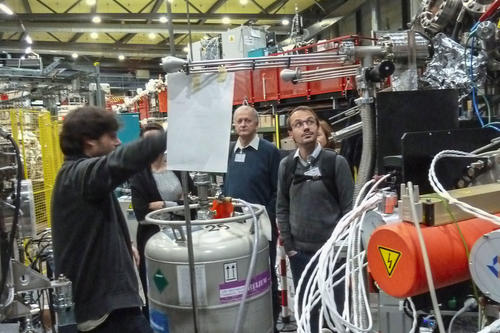The Russian-German Laboratory at BESSY II celebrates twenty years of successful cooperation
Der Speicherring BESSY II wird auch in der kommenden Dekade dem Russisch-Deutschen Labor ausgezeichnete Möglichkeiten bieten.
Image Credit: Eckart Rühl
News from Nov 22, 2021
To commemorate its twentieth year of operations, the Russian-German Laboratory at BESSY II, a particle accelerator that delivers tunable X-rays, held an online workshop on November 18 and 19. At the event, researchers discussed future plans for the Russian-German partnership as well as new goals and developments in innovative projects.
The researchers mostly focus on conducting experiments with new materials and developing technologies for the future. For example, they analyze the properties of carbon nanotubes and conduct electrochemical experiments using the electron storage ring. Their research requires state-of-the-art equipment along with the synchrotron radiation source BESSY II, which is located in Adlershof, a science and technology district in Berlin. The Russian-German laboratory has welcomed numerous researchers from Russia and Germany over the last two decades since its founding. Together they have produced over 770 publications.
The research center has gained the support of eight partner organizations during this time. They include Freie Universität Berlin, the Helmholtz-Zentrum Berlin (HZB), the Technische Universität Dresden (TUD), and the Technische Universität Bergakademie Freiberg. The center also receives support from St. Petersburg State University, the Ioffe Institute in St. Petersburg, the Kurchatov Institute in Moscow, and the Shubnikov Institute of Crystallography in Moscow. In addition, the German Federal Ministry of Education and Research provides financial support for the laboratory. The HZB and the German-Russian Interdisciplinary Science Center (G-RISC) support travel opportunities for researchers who wish to perform measurements at BESSY II. G-RISC is funded by the German Academic Exchange Service (DAAD) with financial backing from the German Federal Foreign Office.
The anniversary workshop has been a chance for researchers to discuss exciting new developments in their research. For example, one presentation looked at the magnetic properties of two-dimensional crystals. Research in this field deals with novel materials that could lead to innovations in computer hardware. Such advances could improve computing performance and energy efficiency in the future. Also, materials used for batteries will be discussed as well as the aspect why certain novel materials in solar cells are proving to be surprisingly efficient.
“What does the future hold for the Russian-German Laboratory?” asked Eckart Rühl, a professor of physical chemistry at Freie Universität Berlin and scientific coordinator of the research laboratory. Plans for new synchrotron radiation sources are already advancing in Germany and Russia. “BESSY II will continue to provide outstanding opportunities for researchers at the Russian-German Laboratory for the decade to come. And the next generation radiation source, BESSY III, which is currently being developed, will make it possible to conduct experiments like we’ve never seen before,” says Professor Jan Lüning, the scientific director of HZB. New partnerships, for example with other research institutes in Russia, could also lead to new developments at the laboratory.
BESSY II
The Helmholtz-Zentrum Berlin enables complex scientific research conducted with the Berlin electron storage ring for synchrotron radiation, known as BESSY II. This ring produces tunable radiation, including X-rays, using electrons that circulate in the storage ring near the speed of light. The Russian-German Laboratory is integrated into this infrastructure and conducts unique experiments at two endstations on the electronic properties of complex materials
More Information on the Russian-German Laboratory at BESSY II
https://www.helmholtz-berlin.de/projects/rgl/index_en.html
Contact
- Prof. Dr. Eckart Rühl, Freie Universität Berlin, Email: ruehl@zedat.fu-berlin.de
- Prof. Dr. Clemens Laubschat, Technische Universität Dresden, Email: claub@physik.phy.tu-dresden.de
- Prof. Dr. Oliver Rader, Email: rader@helmholtz-berlin.de; Prof. Dr. Jan Lüning, Helmholz-Zentrum Berlin, Email: jan.luening@helmholtz-berlin.de
- Prof. Dr. Serguei Molodtsov, TU Bergakademie Freiberg and European XFEL Hamburg, Email: serguei.molodtsov@xfel.eu
